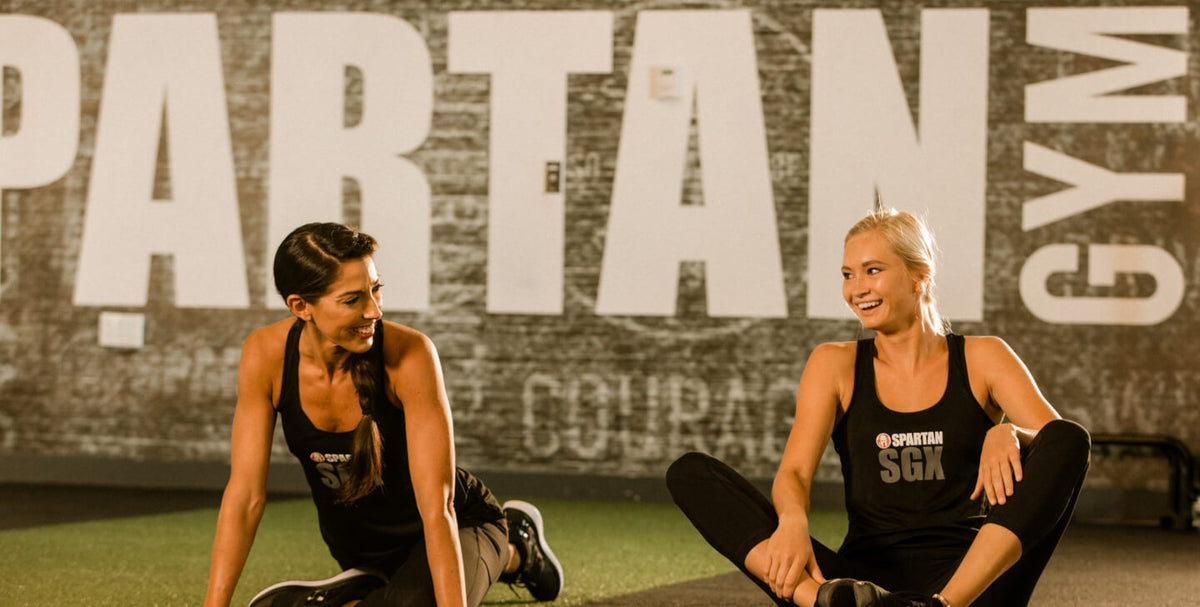5 Best Stretches For Spartans

Whether you are new to racing or an elite competitor, you should always warm up before a workout. You should also do a cool-down after the race and do another set of stretching once you have refueled and hydrated. There are four types of stretching you can do (active, passive, dynamic, and static); however, you can simplify this by learning five key static stretches that will at minimum get you warmed up and ready to race. You can also do these five stretches as soon as you are done to cool down. If done correctly and consistently, you are less likely to suffer an injury, and you will reduce your soreness after tackling race day!
Why Stretch?
Before we get to why we should stretch, let’s quickly cover why so many don’t! Why do so many opt out of stretching? Some would say it’s laziness, but as Spartans we are far from lazy! Like any other workout, we have to add it into our day so that it becomes a habit. It may also be a lack of knowing how to stretch or of complicating stretching to the point where it takes too long to do and people do not want to take the time out to do it. Whatever your reasons for stretching or not stretching, consider the benefits:
Benefits of Stretching
Benefits to warming up before a workout (like a Spartan race) and cooling down afterward:
- Increase flexibility and range of motion. The reason why people stretch is to become more flexible and increase their range of motion. This will help you with mobility and increase your functional movement.
- Reduce risk of injury. This should be the number-one reason why you stretch before and after a race. By stretching, you warm up your muscles, which you will be using for the race. Stretching will also warm up your joints and tendons and other parts of the body that will be used during your race.
- After the race, stretching will promote good blood flow to repair and regenerate your muscles as well. For example, after a race where you use your upper body on a rope climb, rig, or twister, stretching your biceps helps you get the blood into the target zone to help rebuild the muscle and flush lactic acid. This will help reduce soreness.
- The last benefit is that stretching can be done quickly, does not require machines, a gym, or in most cases any help at all. It is also free of charge.
So now that we know why we should stretch, how should we do these stretches?
How to Stretch
As mentioned earlier in the article, there are different types of stretches, and each should be used for specific reasons. With static stretching, we want to hold the position, whereas dynamic stretching will focus on movement. We are looking for simplicity here to get racers (especially new racers) feeling the benefits, so we’ll begin our learning by targeting muscles with static stretches. We want to focus attention on key muscles, so I have supplied a simple series of stretches and areas where you may want to focus. All of these areas will be used during a Spartan race.
Five Stretches You Should Do
Do each of these stretches before and immediately after racing for best results. We will focus on shoulders, arms, legs, back, and hips; however, there are many more you can add once you master these. With all of these stretches, posture is important. Make sure you have good posture, tighten your abdominals, and breathe while stretching.
Stretch 1: Shoulder Stretch
The first one we will discuss is the shoulder stretch. For those of you who are new to fitness, it should be said that if you are likely to have any injury at all, it will most likely be your shoulder. The shoulders are complicated and made up of multiple muscles, so stretching them is imperative to preventing injuries to the rotator cuff. For example, hanging from a rig or monkey bars can stress the muscles of the shoulder, especially if you do not race or train often.
Technique: Cross-Body Arm Stretch
Standing straight and looking forward, take either arm and cross it in front of your body horizontally. Taking your other arm and cross it upward, trapping the horizontal arm, and then press the crossed arm against your body until you feel the stretch in your shoulder. Hold for 15–30 seconds and release. Do this once or twice and make sure you do both shoulders.
Stretch 2: Leg Stretch
When you run a Spartan race, you are likely to be facing many hills in the mountains where races are notoriously staged. Because of this, your quadriceps (or quads for short) generally do a tremendous amount of work, especially when running longer distances with bigger elevation changes like in a Spartan Beast or Ultra Beast. Because of this, stretching the quads is important.
Technique: Standing Quadriceps Stretch
Start standing straight and looking forward. Standing on one leg (you can use something to hold yourself for balance) bring the other leg’s heel to your butt. Hold this position, feeling the stretch in your thigh. Hold for 15–30 seconds and release. Do this once or twice and make sure you do both legs.
Stretch 3: Arm Stretch
One of the best ways to give yourself a warm-up and cool down at a race is to stretch your arms, especially your triceps. You will climbing a lot of walls, pulling yourself up, and holding yourself up.
Technique: Triceps Stretch
Start standing straight and looking forward. Raise one arm above your head and then bend your elbow and try to reach behind and touch the top center of your back. Using your opposite hand, you can grab the extended elbow and lightly pull to help the stretch. Do this once or twice and make sure you do both arms.
Stretch 4: Back Stretch
At a Spartan race you will be expected to do a lot of lifting and carrying of objects such as buckets filled with rocks, sandbags, and logs. When you lift, bend at the knees so your back doesn’t do all of the lifting; however, you will still engage your back muscles while doing these types of obstacles. You should give your back a good stretch before and after the race to reduce the likelihood of an injury.
Technique: Trunk Twist
While sitting on even ground with your legs extended in front of you, take one leg, bend the knee, and cross it over the other, placing the foot flat to the ground. For example, your left leg would be extended and your right left crossed over your left. Twist your upper body in the direction away from your extended leg and hold. You can also twist in the opposite direction. When twisting, try to look behind you. Repeat by extended the right leg and crossing the left leg over and then placing the crossed leg’s foot flat on the ground. Twist in both directions.
Stretch 5: Hip Stretch
Stretching the hip flexors can really help not only in the racing world, but in everything we do. It can also help keep your hips active as we age, which is important. Doing a static hip flexor stretch will be a great overall stretch for your race day as your hips are engaged throughout your run and most of the obstacles you will encounter. When you need to jump a wall or a box jump at a stadium race, you will appreciate stretching your hips. The stretch we will do today will stretch both your hips and your glutes.
Technique: Bridge Stretch
Lie flat on your back on an even surface. Extend your arms outward and down to form a V toward your feet at 45 degrees. Make sure as you lie flat that your legs are shoulder-width apart and bent with your feet flat on the ground. Keeping your feet and your shoulders on the ground, press up through your heels, raising your butt off the floor. Hold for one to three seconds and then recover back to the starting position. Do this 10–12 times.
Summary
You shouldn’t only stretch before and after races; stretching should be something you do often and incorporated into your lifestyle. Learn more ways to stretch and engage the different parts of your body. As well, nutrition and hydration play a key role as well. For example, a hydrated body is more likely to be flexible, pliable, and healthy.
In sum, everything we just learned should take less than 5–10 minutes to do before and then after a race and is well worth the time invested. Stretching is something that we often overlook as part of our warm-ups and workouts, but if done correctly and incorporated into your program, it will provide countless benefits for those who do it. Since a Spartan race is meant to test all aspects of your mind, body, and soul, it is imperative to consider a full-body warm-up before racing. We want to keep racing, so let’s make sure we do everything we can to prevent injury.
4 weeks to fitness. Download the Get Fit Fast Program




